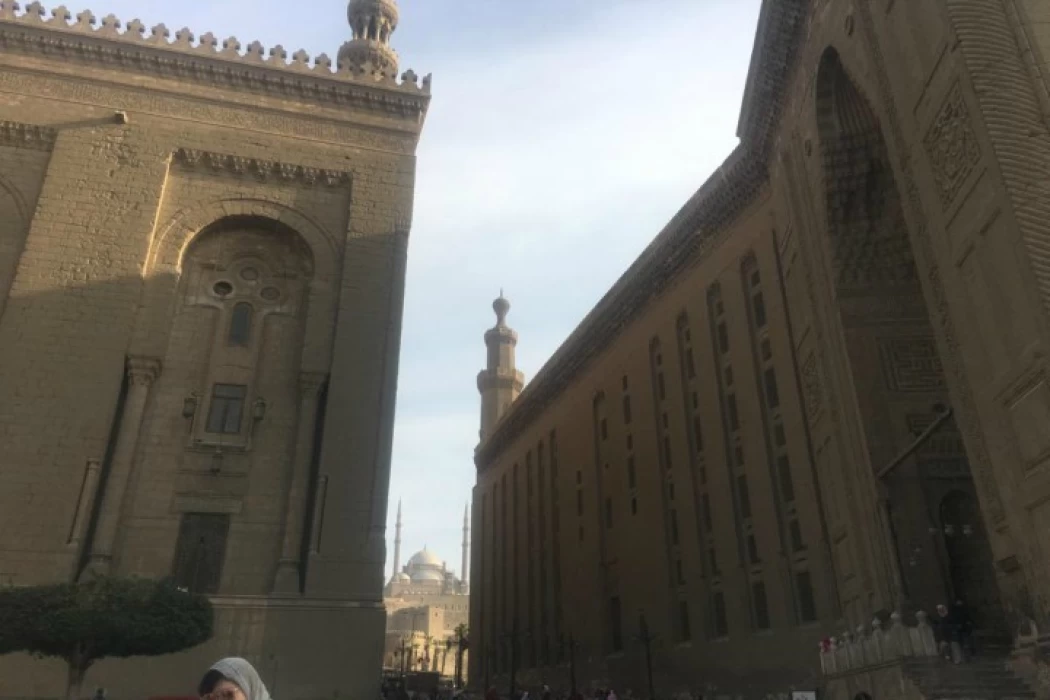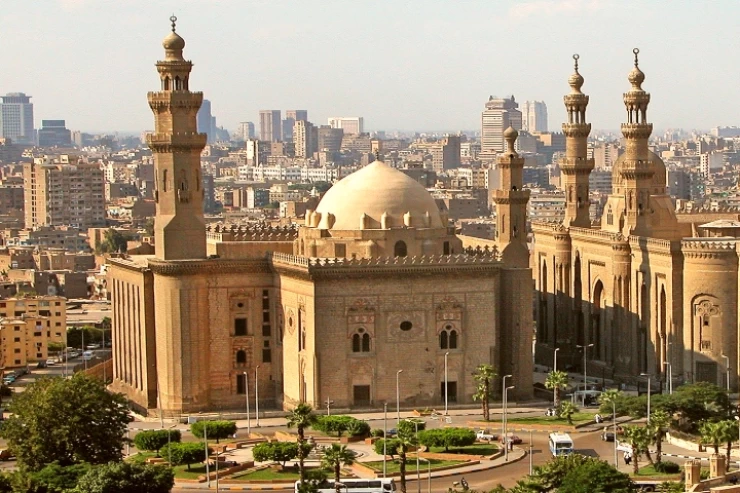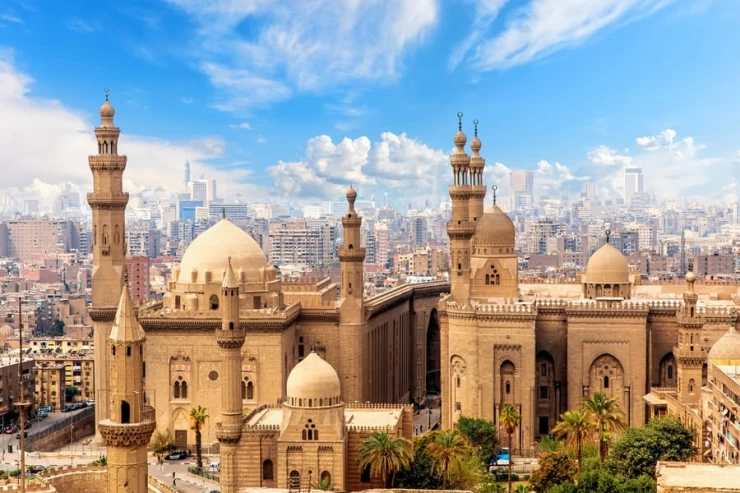
Complexo Sultão Hassan
Mesquita e Madrasa do Sultão Hassan
O Complexo Sultão Hassan é uma combinação com a extensão do edifício, a precisão da indústria e a variedade da decoração, por isso mereceu ser descrito como uma obra-prima da arquitetura e orgulho da antiga arte islâmica.
Cairo Islâmico
É dito sobre a monumental mesquita de "Gomar" em um livro que descreve o Egito.
É um dos edifícios mais bonitos do Cairo por causa de sua cúpula alta, a altura de seu minarete, sua largura, e o luxo e sua decoração. Al-Maqrizi o descreveu como "um dos templos muçulmanos não é conhecido no Islã Isto imita a mesquita".
A maior estrutura do Cairo islâmico, além da porta mais alta, especialmente entre todas as Mesquitas e escolas, fez dela um lugar muito único. O complexo consiste de Música, escola e pernoite para estudantes e professores, tem quatro escolas para ensinar os quatro ritos sunitas.
A Mesquita do Sultão Hassan é um lugar encantador para visitar a qualquer hora e entre as coisas a fazer no Cairo ou talvez em todo o mundo e especialmente no Cairo islâmico. Suas paredes se elevam a 36m de altura e seu minarete mais alto é de 68m. Uma passagem escura de baixo tecto leva você ao pátio quente e cintilante que tem a forma de uma cruciforme. O centro do pátio ficava em uma fonte de abluções abobadada, que provavelmente era uma adição otomana. O deslizamento em quatro lados do pátio é redondo iwans (salas de estar), mantido por correntes de lâmpadas suspensas e aros vermelhos e pretos.
O famoso Sultão Mamluk Hassan que fundou nossa mesquita é o filho do grande Sultão Mamluk Al-Nasser Mohamed Ibn Qalawoun. Ele governou dois reinados interrompidos, a primeira vez em 1347, quando tinha 13 anos de idade, para ser derrubado pelos outros príncipes e generais Mamelucos. A segunda vez foi em 1356A.D, e antes que ele tivesse tempo de pôr fim ao poder dos príncipes e altos funcionários, eles fizeram uma revolução contra ele. Dizia que ele escapou da Cidadela de Salah Eldin, mas foi encontrado e encarcerado, para nunca mais ser visto. Talvez ele tenha sido morto 16 anos após sua elevação ao trono. Ele deixou 10 filhos e 6 filhas para trás.
A mesquita foi construída sobre o sistema de escolas, cada escola é considerada uma pequena mesquita, e cada uma delas é dedicada ao ensino de uma das quatro escolas islâmicas, "Shafi'i, Maliki, Hanbali e Hanafi", a maior destas escolas Hanafi. Ele nomeou um professor para respeitar o Alcorão e, com ele, trinta alunos. Ele também nomeou um professor para o hadith do Profeta, e lhe foi designado um salário de 300 dirhams.
O estilo de planejamento arquitetônico de Mamluk se distingue do qibla iwan que é o maior dos 4 iwans dentro da Mesquita. Ele é feito de mármore e conhecido como o banco do repetidor, localizado em frente ao qibla iwan é (Dekkat Al-Mouballegh), levantado acima de 8 pilares e 3 pilares. Atrás do mihrab, há 2 portas abertas na parede do Quibla que levam a uma cúpula de mausoléu onde o Sultão deve ser enterrado. O teto do Mausoléu tem 21 metros quadrados e sua decoração é semelhante à do qibla iwan.
The Mosque and Madrasa of Sultan Hassan is one of the most stunning examples of Islamic architecture in Cairo, and it is not surprising that the mosque is situated around the Citadel of Saladin, in the interior of Old Cairo. The complex embodies the epic proportions of Mamluk architecture and is famous for its great scale, beautiful intricate patterns and detail, and its past. Visitors around the globe make pilgrimages to the beauty and history of this architectural and cultural masterpiece, which is the pride of the Mamluk Sultanate.
Historical Overview
This mosque and khanqah compound construction was commissioned by Sultan Hassan bin al-Nasir Muhammad around the year 1356 AD, and he intended it to be more than a mosque as it would serve as a madrasa (school of study) for the four major Sunni sects of Islam: Hanafi, Maliki, Shafi’i, and Hanbali. The construction of the tomb was commenced in the 1356 Christian era, which took around seven years to complete. It was also used as a place to learn and worship. But the bad part was that, alas, within a matter of hours, after the Sultan ordered his last and grandest design, the Sultan was assassinated, thus enhancing the myth.
The complex was built in one of the cities that over the years have suffered many interruptions within its history, internally due to earthquakes as well as military sieges, some of which rendered its architectural design adversely. But it has remained a significant symbol of Mamluk rule and devotion and continues to be open for worship and visitors.
While the Sultan Hassan Complex has much to offer, its enormous scale is undoubtedly the most impressive feature. The main entry that is just under 26 meters in height leads to a courtyard that is surrounded by walls that rise to a height of 36 meters. The entire mosque covered about 7900 square meters, making it one of the biggest mosques in the globe. The building’s symmetrical stone elevation and rich use of geometrical decor and ornamental monuments are typical Mamluk architectural designs.
Also, within the mosque’s interior—except for the one iwab—which houses four schools of Sunni Islam and a large central courtyard, which is encircled by four iwans. The Iwan located at the center pointing to Mecca is enhanced with elaborate stucco work and marbles, as well as a decorated'mihrab.'.’ The courtyard is also properly arranged with the help of vertical members in the form of columns. The guests will also admire the lofty walls of the space, which have curved ceilings, creating an almost ethereal feeling in the room.
The organization, which is popularly referred to as the madrasa or Islamic institution in its primary sense, was one of the objects of the original vision of the complex. So all four iwans also served as classrooms for one of the Sunni judicial schools. This period also explains the presence of such illustrious personages in the inner chambers surrounded by students hailing from every corner of the Muslim world due to its esteem as the pinnacle of education.
The institution committed to the good health of its students as well. This implied that in addition to regular classes being offered, nutrition, dormitories, and a reading room were also provided to the students. The madrasah is covered by Koranic verses placed on the walls as ornaments and motivational resources for the student scholars who were within its confines.
Equally intriguing is the tomb of Sultan Hassan, which is another distinguishing element of the Sultan Hassan Complex. The tomb is in the back of the main prayer room and is said to be one of the best preserved examples of Mumluk burial architecture. The dome is surmounted by a giant dome that is 21 meters in height and is embellished with beautiful arabesques and inscriptions. Based within the mausoleum, there lies the sarcophagus of Sultan Hassan, encased in walls of marble embedded with Mamluk-style masterpieces.
Interestingly, Sultan Hassan’s body was never interred in this mausoleum, as he was killed before the complex was completed, and his remains were buried elsewhere. Nevertheless, the mausoleum remains a symbolic resting place and is a beautiful tribute to his memory.
The Sultan Hassan Complex is a superlative work of Islamic art and architecture, with every detail thoughtfully designed and executed to fit the Mamluk style. The walls and ceilings are clad in arabesques, geometric designs, calligraphy, and other typical components of Islamic art. The fishtail and stucco carving works, embellished on the surfaces, unequivocally demonstrate the exceptional artistry that went into building the entire complex.
Among the dominant artistic aspects, one cannot miss the beautiful wooden mashrabiya, which has elaborate floral and geometric carvings in it, encouraging the eye to explore its design. In addition to enhancing the beauty of the complex, these screens also provide ventilation as well as privacy. Another thing that adds beauty to the mosque is its mihrab, which is made of marble and embellished with decorative panels and mosaics that instill a certain level of spirituality.


















